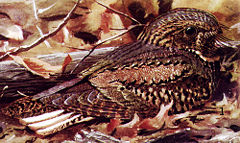Antrostomus
Antrostomus – rodzaj ptaków z podrodziny lelków (Caprimulginae) w rodzinie lelkowatych (Caprimulgidae).
| Antrostomus[1] | |||
| Bonaparte, 1838[2] | |||
 Przedstawiciel rodzaju – lelkowiec karoliński (A. carolinensis) | |||
| Systematyka | |||
| Domena | |||
|---|---|---|---|
| Królestwo | |||
| Typ | |||
| Podtyp | |||
| Gromada | |||
| Podgromada | |||
| Infragromada | |||
| Rząd | |||
| Rodzina | |||
| Podrodzina | |||
| Rodzaj |
Antrostomus | ||
| Typ nomenklatoryczny | |||
|
Caprimulgus carolinensis J.F. Gmelin, 1789 | |||
| Synonimy | |||
| |||
| Gatunki | |||
| |||
Zasięg występowania
edytujRodzaj obejmuje gatunki występujące w Ameryce (Kanada, Stany Zjednoczone, Meksyk, Belize, Gwatemala, Salwador, Honduras, Nikaragua, Kostaryka, Panama, Kuba, Haiti, Portoryko, Saint Lucia, Kolumbia, Wenezuela, Gujana, Surinam, Gujana Francuska, Brazylia, Peru, Boliwia, Paragwaj i Argentyna)[5].
Morfologia
edytujDługość ciała 21–34 cm; masa ciała samców 35–137 g, samic 35–120 g[5].
Systematyka
edytujEtymologia
edytuj- Antrostomus: gr. αντρον antron „grota”; στομα stoma, στοματος stomatos „usta”[6].
- Setochalcis: gr. σης sēs, σητος sētos „ćma”; χαλκις khalkis, χαλκιδος khalkidos „drapieżny, lecz niezidentyfikowany ptak nocny”[7]. Gatunek typowy: Caprimulgus vociferus A. Wilson, 1812.
- Annamormis: Anna May Davis z domu Tarrence (1900–1973), żona amerykańskiego ornitologa L. Irby Davisa; gr. ὁρμιζω hormizō „spoczywać bezpiecznie” (por. ορνις ornis, ορνιθος ornithos „ptak”)[8]. Gatunek typowy: Caprimulgus rufus Boddaert, 1783.
Podział systematyczny
edytujDo rodzaju należą następujące gatunki[9], wyodrębnione z rodzaju Caprimulgus[10][11][12][13]:
- Antrostomus vociferus (A. Wilson, 1812) – lelkowiec krzykliwy
- Antrostomus arizonae Brewster, 1881 – lelkowiec arizoński
- Antrostomus noctitherus (Wetmore, 1919) – lelkowiec czarnogardły
- Antrostomus saturatus Salvin, 1870 – lelkowiec kostarykański
- Antrostomus ridgwayi Nelson, 1897 – lelkowiec brązowoszyi
- Antrostomus salvini (E. Hartert, 1892) – lelkowiec obrożny
- Antrostomus badius Bangs & Peck, 1908 – lelkowiec białosterny
- Antrostomus sericocaudatus Cassin, 1849 – lelkowiec jedwabisty
- Antrostomus carolinensis (J.F. Gmelin, 1789) – lelkowiec karoliński
- Antrostomus rufus (Boddaert, 1783) – lelkowiec rdzawy
- Antrostomus cubanensis Lawrence, 1861 – lelkowiec kubański
- Antrostomus ekmani Lönnberg, 1929 – lelkowiec haitański
Przypisy
edytuj- ↑ Antrostomus, [w:] Integrated Taxonomic Information System (ang.).
- ↑ Ch.-L. Bonaparte: A geographical and comparative list of the birds of Europe and North America. London: J. Van Voorst, 1838, s. 8. (ang.).
- ↑ H.Ch. Oberholser. A monograph of the genus Chordeiles Swainson, type of a new family of Goatsuckers. „Bulletin - United States National Museum”. 86, s. 11, 1914. (ang.).
- ↑ L.I. Davis. Acoustic evidence of relationship in Caprimulginae. „Pan American studies”. 1 (1), s. 39, 1978. (ang.).
- ↑ a b D.W. Winkler, S.M. Billerman & I.J. Lovette, Nightjars and Allies (Caprimulgidae), version 1.0, [w:] S.M. Billerman, B.K. Keeney, P.G. Rodewald & T.S. Schulenberg (redaktorzy), Birds of the World, Cornell Lab of Ornithology, Ithaca, NY 2020, Antrostomus, DOI: 10.2173/bow.caprim2.01 [dostęp 2023-10-13] (ang.).
- ↑ The Key to Scientific Names ↓, Antrostomus [dostęp 2022-01-27].
- ↑ The Key to Scientific Names ↓, Setochalcis [dostęp 2022-01-27].
- ↑ The Key to Scientific Names ↓, Annamormis [dostęp 2022-01-27].
- ↑ Systematyka i nazwy polskie za: P. Mielczarek & M. Kuziemko: Podrodzina: Caprimulginae Vigors, 1825 – lelki (wersja: 2023-09-28). [w:] Kompletna lista ptaków świata [on-line]. Instytut Nauk o Środowisku Uniwersytetu Jagiellońskiego. [dostęp 2023-10-13].
- ↑ G.F. Barrowclough, J.G. Groth & L.A. Mertz. The RAG-1 exon in the avian order Caprimulgiformes: Phylogeny, heterozygosity, and base composition. „Molecular Phylogenetics and Evolution”. 41 (1), s. 238–248, 2006. DOI: 10.1016/j.ympev.2006.05.013. (ang.).
- ↑ K.-L. Han, Molecular Systematics of Nightjars and Nighthawks (Caprimulgidae), [w:] Praca doktorska, University of Maryland [online], 2006, s. 1–86 (ang.).
- ↑ C. Larsen, M. Speed, N. Harvey & H.A. Noyes. A molecular phylogeny of the nightjars (Aves: Caprimulgidae) suggests extensive conservation of primitive morphological traits across multiple lineages. „Molecular Phylogenetics and Evolution”. 42 (3), s. 789–796, 2007. DOI: 10.1016/j.ympev.2006.10.005. (ang.).
- ↑ K.-L. Han, M.B. Robbins & M.J. Braun. A Multi-gene Estimate of Phylogeny in the Nightjars and Nighthawks (Caprimulgidae). „Molecular Phylogenetics and Evolution”. 55 (2), s. 443–453, 2008. DOI: 10.1016/j.ympev.2010.01.023. (ang.).
Bibliografia
edytuj- The Key to Scientific Names, J.A. Jobling (red.), [w:] Birds of the World, S.M. Billerman et al. (red.), Cornell Lab of Ornithology, Ithaca (ang.).